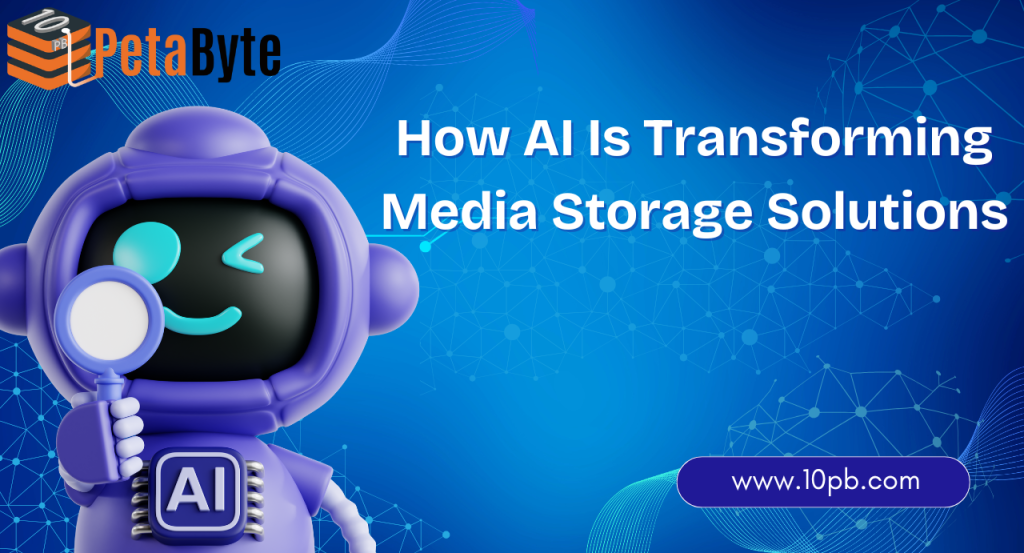In the rapidly evolving digital age, media businesses have to contend with an explosion of content—raw footage, high-definition images, audio files, and finished products—all requiring secure, reliable, and scalable storage. The growing size and complexity of content have led to a new age of innovation, and AI-powered media storage is at its core.
At 10PB, we know the future of media storage is smart, self-driving, and AI-based. Here’s how artificial intelligence is changing the landscape of media storage and why media, entertainment, broadcasting, and digital content creation companies are adopting AI-based storage solutions.
The Emergence of Data in Media Production
The entertainment and media industry has become one of the world’s largest generators of data. IDC estimates that more than 175 zettabytes of data will be created by 2025—and among them, media firms are key players. With 4K, 8K, VR, and 360-degree video, conventional storage infrastructure is lagging behind.
AI-driven systems that can manage massive volumes of content while ensuring accessibility, security, and performance. Solutions like 10 Petabyte (10 PB) object storage are emerging as ideal choices, offering high-capacity, scalable, and cost-effective infrastructure to handle the growing demands of media production.
How Media Storage Solutions are Revolutionized Primarily through AI
Let’s examine the fundamental innovations and advantages AI is bringing into media storage systems.
- Automated metadata tagging
In conventional workflows, human tagging of media content is both labor-intensive and error-prone.Today, many AI tools create metadata automatically by detecting the faces, objects, locations, and even emotions in image or video content.
✅ Advantages:
- Accelerated content retrieval and indexing
- Improved searchability within vast archives
- Streamlined editing and production processes
Google Video AI and IBM Watson Media are just some of the pieces of software that have made this possible, enabling production houses to focus on art, rather than on file management.
- Smart Storage Tiering
AI can scan usage patterns and automatically move media files across various tiers of storage depending on frequency of access, age of content, or value.
✅ Advantages:
- Lower overall cost of storage
- Optimizes active project performance
- Prevents archival content from being lost
- Such smart placement of data is especially useful in hybrid and cloud storage setups, where expenses easily spiral out of control.
- Predictive Storage Scaling
AI calculations forecast storage requirements from project pipelines, content types, and collaboration requirements.
✅ Advantages:
- Prevents surprise storage shortages
- Allows seamless planning of projects
- Boosts planning for the budget of media organizations
- This functionality is invaluable in high-pressure environments like news rooms or production studios, where unexpected storage bursts can derail timeliness.
- Content Recommendation & Reusability
AI identifies similarity across stored content and provides reusable assets to apply to new work. This stimulates creativity and productivity.
✅ Benefits:
- Saves time locating related footage
- Avoids repetitive storage of identical content
- Assists creators in discovering gems
- It’s especially useful in documentary filmmaking, advertising campaigns, and brand narratives.
- Improved Data Security & Compliance
Media storage systems are increasingly being targeted with cyber attacks. AI improves data security by detecting anomalies and breaches in real-time.
✅ Benefits:
- Identifies unauthorized access
- Marks suspicious file transfers or edits
- Guarantees data compliance with regulations (GDPR, HIPAA, etc.)
- Media organizations that own sensitive content, like unpublished shows or exclusive interviews, benefit tremendously from this level of protection.
- AI-Powered Compression & Encoding
AI compresses video files through smart compression without compromising quality. This greatly reduces storage space.
✅ Benefits:
- Lower storage costs
- Faster file transfers
- Efficient network delivery
This is particularly critical for streaming service and OTT media streaming services, where user experience and performance depend on file optimization.
Use Cases In the Media Industry
Following are a few examples of how AI is revolutionizing media storage solutions:
Film Studios
AI allows for the tagging of production footage to be automated so that editors can locate scenes in an instant. It also drives content safety with global collaboration.
Broadcast Networks
AI is utilized by broadcasters for real-time metadata tagging, ensuring quicker airing of breaking news and archiving huge amounts of footage for potential reuse.
Photography Agencies
AI facilitates image deduplication and keyword tagging, rendering huge photo libraries easier to manage and search.
Digital Newsrooms
AI determines trending themes and bridges them to cached visual content to allow for rapid assembly by journalists into compelling tales.
The Future of Media Storage: AI-First Workflows
As AI-powered media storage technology, we are heading toward AI-first media storage systems that not only store data but also make it intelligent, interactive, and instantly usable. In this evolution, high-capacity solutions like 10 Petabyte Storage stand out as ideal for media organizations managing ever-growing libraries of video, audio, and image assets. With both scale and intelligence, platforms like these provide the perfect foundation for AI integration.
Future advancements may include:
- Real-time content monetization alerts
- AI-assisted content licensing workflows
- Emotion-based tagging for targeted campaigns
- Voice-to-indexed video conversions
- Autonomous compliance audits for stored content
Media organizations that invest early in AI-powered media storage, large-scale storage solutions like 10 PB will enjoy faster workflows, smarter content reuse, and a stronger competitive edge.
Choosing the Best AI-Powered Media Storage Platform
When selecting an AI-driven media storage platform, keep in mind the following:
- AI Feature Set – Look for platforms that have metadata automation, predictive scaling, and smart tiering.
- ☁️ Cloud Compatibility – Ensure the system inherently resides in public or private cloud platforms.
- Security Standards – Check for encryption, threat detection, and access controls powered by AI.
- ⚙️Scalability & Performance – The platform should grow with your needs without sacrificing speed or reliability.
- Ease of Use – AI capabilities must be simple and intuitive and not need complicated coding or technical experience.
Last Thoughts
As media data increases in volume, so will the demand for smart systems that are more than mere repositories—they must help you use data intelligently and efficiently. This is where solutions like 10 Petabyte (10 PB) Object Storage powered by Netforchoice(NFC) stand out. Designed to handle vast datasets with high performance and scalability, it’s a future-ready option that pairs perfectly with AI-powered media storage workflows—ensuring your media content is always secure, searchable, and ready to monetize.
And that’s precisely where AI is taking the future forward.
FAQ’s
Q1. What is the role of AI in media storage solutions?
AI is utilized for automated metadata tagging, smart tiering, predictive scaling, content recommendations, and security.
Q2. What are the advantages of AI-powered media storage?
It enhances searchability, lowers storage expenditures, increases security, and simplifies content workflows.
Q3. Will AI be able to decrease media storage costs?
Yes, AI optimizes data placement and compression, which profoundly decreases storage and operational expenses.
Q4. Is AI media storage appropriate for small production teams?
Yes, AI solutions scale according to needs and are therefore perfect for small teams and large-scale organizations alike.
Q5. Does AI enhance media file search and access?
Yes, AI-automatic metadata enables media content to be searched and accessed more easily and quickly and reused.


